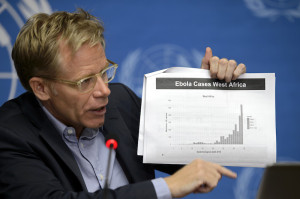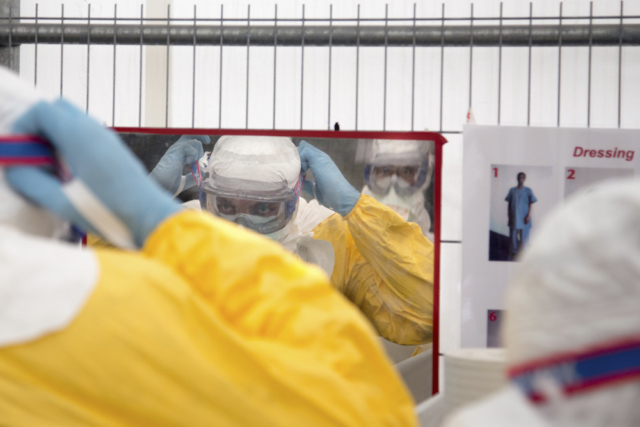The Ebola virus has been known to have a mortality rate of up to 90 percent. How does the current outbreak — which may take another nine months to contain — compare?
There have been 3,069 cases of Ebola in West Africa, accounting for at least 1,552 deaths. In general, the current outbreak has had a mortality rate of 50.5 percent — about half of those who contracted Ebola have survived. But that reality looks very different country to country, and over the course of the outbreak.
Liberia has been hit especially hard in terms of the sheer spread — 1,378 cases have been recorded there, more than any other country. But Guinea has seen the highest mortality rate — of the 648 cases, almost exactly two-thirds have died.
But WHO estimates that in some hot-spot zones the actual number of cases may be two to four times higher than the official count.

Bruce Aylward, WHO Assistant Director-General, speaks to the media during a press conference about the WHO briefing on the Ebola roadmap at the European headquarters of the U.N. in Geneva, Thursday, Aug. 28, 2014. Photo: AP/Keystone/Martial Trezzini
“This far outstrips any historic Ebola outbreak in numbers,” Dr. Bruce Aylward, WHO’s assistant director-general, told reporters Thursday, adding that the largest previous outbreak was about 400 cases. “This is a global health security issue.”
WHO released a roadmap to combat the current outbreak Thursday, with the goal of ending the outbreak within eight to nine months. It’s designed to address a caseload that could exceed 20,000 Ebola patients.
“20,000 is a scale that has, I think, not ever been anticipated in terms of an Ebola outbreak,” Aylward said, adding that they were not expecting 20,000 cases and that that figure would be “completely unacceptable. But we have got to have a system that is robust enough to deal with … a very bad case scenario.”
Doing so will cost an estimated $489 million and require nearly 13,000 workers. “Not (just) talking about this like I am, but being right out their in the field level, in the districts actually running the operations,” he said. “That’s the scale of manpower needed to do this.”
Data: World Health Organization. All case numbers reflect the total number of probable and confirmed cases of Ebola virus disease. Dates reflect the date WHO released updated data. The first case in Nigeria was officially counted on July 31.
And the outbreak’s accelerating. According to WHO, more than 40 percent of cases have occurred within the last three weeks. But preliminary analysis indicates the outbreak’s spread is not accelerating at the same rate. Almost two-thirds of all the reported cases since the its onset are still concentrated in the epicenter of the outbreak: Gueckedou, Guinea; Lofa, Liberia; and Kenema and Kailahun in Sierra Leone.
This #Ebola outbreak is fast-moving w/ unprecedented dimensions. WHO roadmap aims to be flexible enough to accommodate rapid changes & needs
— WHO (@WHO) August 28, 2014
The disease spreads through human-to-human contact. Overcrowded cities, where dozens of people may share a single, modest house, are at high risk for contracting the disease. Health care workers also have a particularly high risk, and an unprecedented number have become infected. At least 240 have developed the disease, and more than 120 have died. Medical staff face hurdles like shortages of protective equipment (or none at all), not enough people to proportionately staff against the outbreak, and, ironically, compassion — some medical staff have been working in isolation wards far beyond the recommend “safe” number of hours.
Read the full roadmap here:
 CGTN America
CGTN America
 A participant is reflected in a mirror during a Doctors Without Borders training course to instruct NGO workers and doctors on how to deal with the Ebola virus in Brussels on Tuesday, Aug. 26, 2014. Photo: AP/Olivier Matthys
A participant is reflected in a mirror during a Doctors Without Borders training course to instruct NGO workers and doctors on how to deal with the Ebola virus in Brussels on Tuesday, Aug. 26, 2014. Photo: AP/Olivier Matthys
